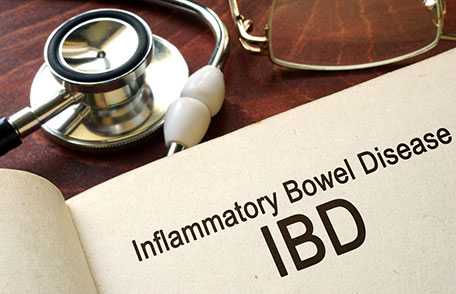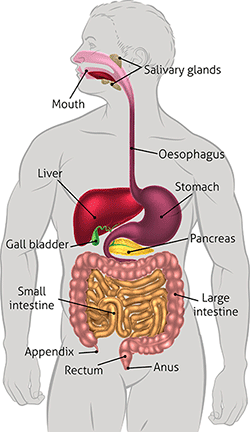Inflammatory Bowel Disease (IBD): What Is It?

Inflammatory Bowel Disease (IBD) is an autoimmune disease where the body attacks its own tissues. The estimated number of adults in the U.S. reporting being diagnosed with IBD has increased greatly since 1999.
The estimated number of adults in the U.S. reporting being diagnosed with Inflammatory Bowel Disease (IBD) has increased greatly since 1999 from 2 million to 3 million. However, these estimates do not include those under the age of 18 who may also have the disease.
What is IBD?
Inflammatory bowel disease (IBD) is a term for two conditions (Crohn’s disease and ulcerative colitis) that are characterized by chronic inflammation of the gastrointestinal (GI) tract, which extends from the mouth to the anus and includes the organs that digest food, absorb nutrients, and process wastes.1 Long-term inflammation results in damage to the GI tract.
What are the symptoms of IBD?
Some common symptoms are:
- Persistent diarrhea
- Abdominal pain
- Rectal bleeding/bloody stools
- Weight loss
- Fatigue
Some of the differences between Crohn’s disease and ulcerative colitis:
| Crohn’s Disease | Ulcerative Colitis |
|---|---|

|

|

Inflammatory bowel disease is a collection of inflammatory conditions of colon and small intestine.
How common is IBD in the United States?
In 2015, an estimated 1.3% of U.S. adults (3 million) reported being diagnosed with IBD (either Crohn’s disease or ulcerative colitis).2 This was a large increase from 1999 (0.9% or 2 million adults).3
Some groups were more likely to report IBD, including those:
- Aged 45 years or older.
- Hispanic or non-Hispanic white.
- With less than a high school level of education.
- Not currently employed.
- Born in the U.S. (compared with adults born outside the U.S.).
- Living in poverty.
- Living in suburban areas.
This estimate does not include children younger than18 years old, who may also have IBD. Most people with IBD are diagnosed in their 20s and 30s.
What causes IBD?
The exact cause of IBD is unknown, but IBD is the result of an immune system which is not working the way it should. A properly functioning immune system attacks foreign organisms, such as viruses and bacteria, to protect the body. In IBD, the immune system responds incorrectly to environmental triggers such as smoking, virus, or bacteria, which may cause inflammation of the GI tract. There also appears to be a genetic component—someone with a family history of IBD is more likely to develop this inappropriate immune response.
How is IBD diagnosed?
IBD is diagnosed using a combination of endoscopy or colonoscopy (both of which let your doctor see inside your body by inserting an instrument with a very small camera), and radiologic imaging (such as X-rays, CT scans, or MRIs) to diagnose IBD. These results together with blood or stool tests will help doctors make a diagnosis of IBD.
How is IBD treated?
Several types of medications may be used to treat IBD. Several vaccinations for patients with IBD are also recommended to prevent infections. Severe IBD may require surgery to remove damaged portions of the GI tract, but advances in treatment with medications mean that surgery is less common than it was a few decades ago. Since Crohn’s disease and ulcerative colitis affect different parts of the GI tract, the surgical procedures are different for the two conditions.
IBD is not Irritable Bowel Syndrome (IBS)…
IBD should not be confused with irritable bowel syndrome or IBS. Although people with IBS may experience some similar symptoms to IBD, IBD and IBS are very different. Irritable bowel syndrome is not caused by inflammation and the tissues of the bowel are not damaged the way they are in IBD. Treatment is also different. To learn more about the difference between inflammatory bowel disease and irritable bowel syndrome, go to IBS and IBD: Two Very Different Disorders.
IBD is not celiac disease…
Celiac disease is another condition with similar symptoms to IBD. It is also characterized by inflammation of the intestines. However, the cause of celiac disease is known and is very specific. It is an inflammatory response to gluten (a group of proteins found in wheat and similar grains). The symptoms of celiac disease will go away after starting a gluten-free diet, although it usually will be months before the full effects of the new diet will be reached.
More Information
References
- The Facts About Inflammatory Bowel Diseases. [2.32 MB] New York, NY: Crohn’s and Colitis Foundation of America; 2014.
- Dahlhamer JM, Zammitti EP, Ward BW, Wheaton AG, Croft JB. Prevalence of inflammatory bowel disease among adults aged ≥18 years — United States, 2015. MMWR Morb Mortal Wkly Rep. 2016;65(42):1166-1169. [717 KB]
- Nguyen GC, Chong CA, Chong RY. National estimates of the burden of inflammatory bowel disease among racial and ethnic groups in the United States. J Crohns Colitis. 2014;8:288–95.
- Page last reviewed: May 22, 2017
- Page last updated: May 22, 2017
- Content source:
- National Center for Chronic Disease Prevention and Health Promotion, Division of Population Health
- Page maintained by: Office of the Associate Director for Communication, Digital Media Branch, Division of Public Affairs




 ShareCompartir
ShareCompartir